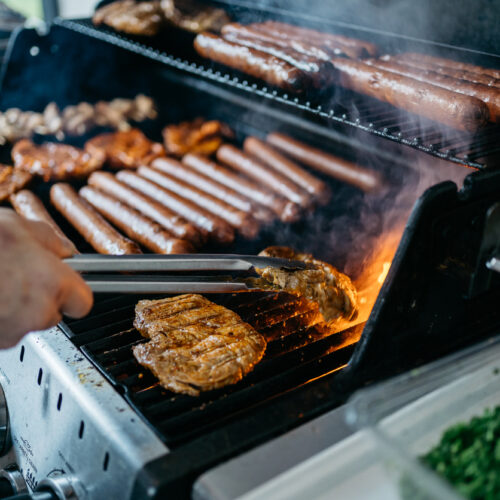
As coronavirus restrictions begin easing, you may be wondering if it’s safe to fly for work or to see loved ones. Healthy Food Guide editor Jenny de Montalk looks at expert advice on how to minimise your risk of catching or spreading COVID-19 when travelling on flights.
1 If you’re at high-risk of coronavirus complications, delay your travel
Anyone who is immunocompromised, in the older age bracket (over 60) or unwell, is best to delay flying, for now.
If you have any potential COVID-19 symptoms, such as fever, cough or trouble breathing, stay at home and get tested.
If you are unwell and try to board a flight, the airline is within their rights to refuse boarding.
Ensure you are healthy and the people you are visiting are healthy and consider if there are other options for travel. Can you drive to your destination, for instance? If flying is your only option, make sure you minimise the risks with the following advice.
2 Physical distancing on planes during COVID-19
The biggest risk when it comes to travelling during the coronavirus pandemic, by air, bus or train, is that physical distancing is difficult. Current physical distancing recommendations are to keep at least 2 metres apart from other members of the public.
Research on droplet-mediated respiratory disease shows a low probability of inflight transmission, if passengers are not seated in close proximity to each other. So, the first thing to do is check the airline’s policy on seating. Some airlines are leaving middle seats unoccupied and having empty rows, to help keep passengers distanced. These are the flights you want to go for.
It’s important you sit in the seat allocated to you, so you can be easily traced if there is an instance of an infected person near you on the plane.
If you can, choose a window seat, as this will reduce the number of passengers you are exposed to inflight. But try to avoid touching the wall and window and touching your face during the flight. If you do touch the wall or window cover, wash your hands with soap and water after or use hand sanitiser.
For the safety of other passengers, make sure you follow respiratory/cough etiquette (coughing or sneezing into a disposable tissue or the crook of your arm) and sanitise your hands after blowing your or a child’s nose.
3 The risk of COVID-19 from surfaces on planes and in airports
The other big risk is from contact with potentially contaminated surfaces such as armrests, seats, tray tables, toilet facilities and handles.
Make sure you are prepared with hand sanitiser, disposable tissues and disinfectant wipes. Wash your hands as often as possible or use hand sanitiser.
Stay in the main lounge until your flight is ready to board, rather than wandering around the airport terminal. And if you eat at the food court or airport café make sure you wash or sanitise your hands before eating.
Once you get to your seat on the aircraft, stay there. Try to book short flights only, even if this means multiple flights, so you can avoid using the onboard toilet facilities. If you do need to use them, remember your hand hygiene and to avoid touching your face.
4 Can I get sick from the air on the plane?
According to the World Health Organization there is little risk of communicable disease transmission via cabin air, because it is carefully controlled.
“Most modern aircraft have recirculation systems, which recycle up to 50 per cent of cabin air. The recirculated air is usually passed through high-efficiency particulate air (HEPA) filters of the type used in hospital operating theatres and intensive care units, which trap dust particles, bacteria, fungi and viruses”, WHO air travel advice says.
If you are concerned, contact your airline to find out what the air recirculation systems and policies are on the model of aircraft you will be travelling on.
5 Should I wear a mask on the plane?
Official advice on wearing masks varies from country to country but you are able to wear a mask if you choose to.
In a Spinoff article, microbiologist Siouxsie Wiles suggests wearing face masks when in badly ventilated areas or places wear physical distancing is difficult.
An aircraft is not a badly ventilated space but physical distancing may be hard so, if you want to wear one, this might be the place to do it.
However, if you do wear a mask make sure you wear it properly, so it covers the nose and the mouth at all times, and avoid touching the front of the mask or overhandling it.
Article sources and references
- Vicki Stover Hertzberg, et al. Behaviors, movements, and transmission of droplet-mediated respiratory diseases during transcontinental airline flights. PNAS April 3, 2018 115 (14) 3623-3627; first published March 19, 2018 https://doi.org/10.1073/pnas.1711611115https://www.pnas.org/content/115/14/3623
- Handbook for the Management of Public Health Events in Air Transport. Updated with information on Ebola virus disease and Middle East respiratory syndrome coronavirus. Accessed May 2020https://apps.who.int/iris/bitstream/handle/10665/204628/9789241510165_eng.pdf;jsessionid=3718D2BCB4ACD0E54640FF68C3E9CC44?sequence=1
- Coronavirus disease (COVID-19) advice for the public: When and how to use masks. World Health Organizationhttps://www.who.int/emergencies/diseases/novel-coronavirus-2019/advice-for-public/when-and-how-to-use-masks
- Updated WHO recommendations for international traffic in relation to COVID-19 outbreakhttps://www.who.int/news-room/articles-detail/updated-who-recommendations-for-international-traffic-in-relation-to-covid-19-outbreak
- COVID-19 frequently asked questions. Auckland Airporthttps://www.aucklandairport.co.nz/information/novel-coronavirus-frequently-asked-questions
- COVID-19 (Coronavirus)https://safetravel.govt.nz/covid-19-coronavirus
www.healthyfood.com










